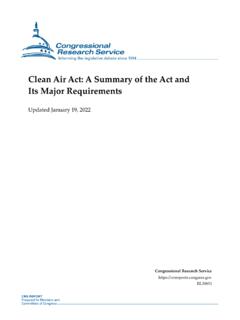Transcription of review of roles - Professional Standards Authority for ...
1 Literature review of roles and issues within the social work profession in England Jo Moriarty Mary Baginsky Jill Manthorpe March 2015 Contents Summary .. ii Terms of reference and methods .. 1 Terms of 1 Methods .. 1 Background .. 2 Limitations of existing data about social work and social workers in England .. 3 Defining social work .. 3 Global definition of social work .. 4 Need for a public definition of social work? .. 5 Different kinds of job roles social workers perform .. 6 Table 1: Typologies of social work roles .. 7 Social workers responsibilities and tasks .. 7 Table 2: Social workers responsibilities and tasks.
2 8 Specialisation .. 10 Conflicts and tensions between different roles and responsibilities .. 11 Role ambiguity and role conflict .. 12 Professional discretion and time on administration .. 13 Where social workers are employed .. 14 Team structure and supervision .. 17 Team structures .. 17 Supervision .. 17 Working with other professionals .. 18 Prevalence of stress, depression, alcohol and drug problems .. 19 Regulation .. 21 Changes and concerns .. 22 Social work reform .. 22 Concerns .. 23 References .. 24 i Summary This review was commissioned by the Professional Standards Authority to help inform its work overseeing the regulation of social workers in England and accrediting voluntary registers for care occupations.
3 We were asked to identify what research tells us about the variety of roles and contexts that social workers work in and the main issues in the profession with relevance to its regulation. In order to do this, we undertook systematic searches of a range of bibliographic databases and websites supplemented by searches of tables of contents in key journals and checking the reference lists of relevant articles in order to identify material that had not been retrieved in the searches. The review showed that definitions of social work have always been contested and that the activities that social workers do are strongly influenced by the expectations about their role that predominate in the countries and agencies in which they practise.
4 There is an ongoing debate about what should be the balance between social work activities aimed at supporting individuals and their families, for example, advocacy, and safeguarding activities especially aimed at protecting children or adults at risk. Some commentators suggest that social work is especially characterised by combining support for individuals and work at a collective level to achieve social transformation. There is clearly some overlap between the activities that social workers do and those undertaken by other professionals but we did not identify any recent research that looked at this in detail.
5 Most routes to a qualification in social work have been generic, with most choosing to specialise in different areas of practise after qualifying. However, new fast track qualifying routes are emerging which specialise in either adults or children s social work. This has attracted some controversy. There is an established evidence base, mainly but not exclusively originating in work from outside the United Kingdom, highlighting the negative effects of role conflict and role ambiguity. There is an extensive evidence base consisting of research undertaken within and outside the United Kingdom highlighting high rates of stress and burnout among social workers.
6 The extent to which social workers can exercise Professional discretion and the amount of administration they need to undertake has been identified as contributing to poor retention rates and/or burnout. ii iii Good supervision is thought to improve retention rates and prevent burnout but most of the research on supervision has been undertaken outside the United Kingdom. Social work was comparatively late in becoming a regulated profession. It has been suggested that there has been more emphasis in reports and inquiries into identifying procedural errors or omissions than in clarifying poor practice and when fitness to practise procedures should be invoked but this is an area in which the research evidence base is still comparatively of reference and methods Key point: This section explains the terms of reference for this literature review and the methods used to retrieve the items included.
7 Terms of reference This report was commissioned by the Professional Standards Authority to help inform its work overseeing the regulation of social workers in England and accrediting voluntary registers for care occupations. We were asked to provide information on the following: What is the profile of the social worker profession in England in terms of: A breakdown of the different kinds of job roles social workers perform The responsibilities and tasks those roles involve The structure of teams social workers work within and the types and frequency of supervision social workers receive Which regulated professionals and unregulated occupations social workers work with or liaise with The nature of employment (for example local Authority , other public sector, education sector, private sector, third sector, social enterprises, self employed)
8 What organisations exist that seek to represent/support social workers The prevalence of stress, depression, alcohol and drug problems amongst practising social workers What are the main changes on the horizon for the social work profession in England? For example, greater integration between health and social care; changes in social work practices the Children and Families Act 2014 and Care Act 2014 will introduce; changes to social work training following the Narey and Croisdale Appleby reviews This review complements research commissioned concurrently by the Professional Standards Authority looking at service users views of social workers.
9 Methods We used a scoping methodology to identify material for inclusion in this review . Definitions of scoping studies vary but they generally involve a process of systematic searching to map rapidly the key concepts underpinning a research area followed by charting and sorting the information retrieved according to key issues and themes. The ensuing review can be used to identify gaps in the research as well as what is known about a particular topic or topics (Arksey and O'Malley, 2005; Levac et al., 2010; Moriarty and Manthorpe 2014). 1 We searched the following electronic bibliographic databases using a combination of fixed terms from their thesauri and free text searches for each of the key topic areas covered in this review ( roles , responsibilities, interprofessional working, employment, team structure, supervision, stress, burnout, and qualifying education): Social Care Online, Social Work Abstracts, Sociological Abstracts, International Bibliography of the Social Sciences, PsycINFO, Education Abstracts, CINAHL, Zetoc, HMIC, and Web of Science.
10 We also undertook searches of the following websites that we considered to be particularly important in terms of relevant information: British Library Social Welfare Portal; Social Care Institute for Excellence; Health and Care Professions Council; Department of Health; Department for Education; Skills for Care; British Association of Social Workers; Professional Standards Authority ; and The College of Social Work. We also made general internet searches, including Google Scholar. We hand searched the table of contents of British Journal of Social Work, Journal of Interprofessional Care, and Child and Family Social Work for the previous five years and reference harvested the bibliographies in key journal articles and reports to identify other relevant material that had not come up in the database or website searches.

